Feedback Control of a Nonholonomic Car-like
Robot
A. De Luca
G. Oriolo
C. Samson
This is the fourth chapter of the book:
Robot Motion Planning and Control
Jean-Paul Laumond (Editor)
Laboratoire d’Analye et d’Architecture des Syst`emes
Centre National de la Recherche Scientifique
LAAS report 97438
Previoulsy published as:
Lectures Notes in Control and Information Sciences 229.
Springer, ISBN 3-540-76219-1, 1998, 343p.
�
Feedback Control of a
Nonholonomic Car-Like Robot
A. De Luca1, G. Oriolo1 and C. Samson2
1 Universit`a di Roma “La Sapienza”
2 INRIA, Sophia-Antipolis
1 Introduction
The subject of this chapter is the control problem for nonholonomic wheeled
mobile robots moving on the plane, and in particular the use of feedback tech-
niques for achieving a given motion task.
In automatic control, feedback improves system performance by allowing the
successful completion of a task even in the presence of external disturbances
and/or initial errors. To this end, real-time sensor measurements are used to
reconstruct the robot state. Throughout this study, the latter is assumed to
be available at every instant, as provided by proprioceptive (e.g., odometry) or
exteroceptive (sonar, laser) sensors.
We will limit our analysis to the case of a robot workspace free of obstacles.
In fact, we implicitly consider the robot controller to be embedded in a hierar-
chical architecture in which a higher-level planner solves the obstacle avoidance
problem and provides a series of motion goals to the lower control layer. In this
perspective, the controller deals with the basic issue of converting ideal plans
into actual motion execution. Wherever appropriate, we shall highlight the in-
teractions between feedback control and motion planning primitives, such as
the generation of open-loop commands and the availability of a feasible smooth
path joining the current robot position to the destination.
The specific robotic system considered is a vehicle whose kinematic model
approximates the mobility of a car. The configuration of this robot is repre-
sented by the position and orientation of its main body in the plane, and by
the angle of the steering wheels. Two velocity inputs are available for motion
control. This situation covers in a realistic way many of the existing robotic
vehicles. Moreover, the car-like robot is the simplest nonholonomic vehicle that
displays the general characteristics and the difficult maneuverability of higher-
dimensional systems, e.g., of a car towing trailers. As a matter of fact, the
control results presented here can be directly extended to more general kine-
matics, namely to all mobile robots admitting a chained-form representation.
In particular, our choice encompasses the case of unicycle kinematics, another
ubiquitous model of wheeled mobile robot, for which simple but specific feed-
back control methods can also be derived.
�
172
A. De Luca, G. Oriolo and C. Samson
The nonholonomic nature of the car-like robot is related to the assump-
tion that the robot wheels roll without slipping. This implies the presence of
a nonintegrable set of first-order differential constraints on the configuration
variables. While these nonholonomic constraints reduce the instantaneous mo-
tions that the robot can perform, they still allow global controllability in the
configuration space. This unique feature leads to some challenging problems
in the synthesis of feedback controllers, which parallel the new research issues
arising in nonholonomic motion planning. Indeed, the wheeled mobile robot
application has triggered the search for innovative types of feedback controllers
that can be used also for more general nonlinear systems.
In the rest of this introduction, we present a classification of motion control
problems, discussing their intrinsic difficulty and pointing out the relationships
between planning and control aspects.
1.1 Problem classification
In order to derive the most suitable feedback controllers for each case, it is
convenient to classify the possible motion tasks as follows:
– Point-to-point motion: The robot must reach a desired goal configuration
starting from a given initial configuration.
– Path following: The robot must reach and follow a geometric path in the
cartesian space starting from a given initial configuration (on or off the
path).
– Trajectory tracking: The robot must reach and follow a trajectory in the
cartesian space (i.e., a geometric path with an associated timing law) start-
ing from a given initial configuration (on or off the trajectory).
The three tasks are sketched in Fig. 1, with reference to a car-like robot.
Using a more control-oriented terminology, the point-to-point motion task is
a stabilization problem for an (equilibrium) point in the robot state space. For a
car-like robot, two control inputs are available for adjusting four configuration
variables, namely the two cartesian coordinates characterizing the position of
a reference point on the vehicle, its orientation, and the steering wheels angle.
More in general, for a car-like robot towing N trailers, we have two inputs for
reconfiguring n = 4 + N states. The error signal used in the feedback controller
is the difference between the current and the desired configuration.
�
Feedback Control of a Nonholonomic Car-Like Robot
173
Fig. 1. Motion tasks: Point-to-point motion (a), Path following (b), Trajectory
tracking (c)
����������
�����
������������������������� !�"�#�$�����%���#���$&('*)#��
�,+��-.�/�0�������#�1�2435176.1789:�
174
A. De Luca, G. Oriolo and C. Samson
In the path following task, the controller is given a geometric description of
the assigned cartesian path. This information is usually available in a param-
eterized form expressing the desired motion in terms of a path parameter σ,
which may be in particular the arc length along the path. For this task, time
dependence is not relevant because one is concerned only with the geometric
displacement between the robot and the path. In this context, the time evolu-
tion of the path parameter is usually free and, accordingly, the command inputs
can be arbitrarily scaled with respect to time without changing the resulting
robot path. It is then customary to set the robot forward velocity (one of the
two inputs) to an arbitrary constant or time-varying value, leaving the second
input available for control. The path following problem is thus rephrased as the
stabilization to zero of a suitable scalar path error function (the distance d to
the path in Fig. 1b) using only one control input. For the car-like robot, we shall
see that achieving d ≡ 0 implies the control of three configuration variables—
one less than the dimension of the configuration space—because higher-order
derivatives of the controlled output d are related to these variables. Similarly,
in the presence of N trailers, requiring d ≡ 0 involves the control of as many
as n − 1 = N + 3 coordinates using one input.
In the trajectory tracking task, the robot must follow the desired carte-
sian path with a specified timing law (equivalently, it must track a moving
reference robot). Although the trajectory can be split into a parameterized ge-
ometric path and a timing law for the parameter, such separation is not strictly
necessary. Often, it is simpler to specify the workspace trajectory as the de-
sired time evolution for the position of some representative point of the robot.
The trajectory tracking problem consists then in the stabilization to zero of
the two-dimensional cartesian error e (see Fig. 1c) using both control inputs.
For the car-like robot, imposing e ≡ 0 over time implies the control of all four
configuration variables. Similarly, in the presence of N trailers, we are actually
controlling n = N + 4 coordinates using two inputs.
The point stabilization problem can be formulated in a local or in a global
sense, the latter meaning that we allow for initial configurations that are arbi-
trarily far from the destination. The same is true also for path following and
trajectory tracking, although locality has two different meanings in these tasks.
For path following, a local solution means that the controller works properly
provided we start sufficiently close to the path; for trajectory tracking, close-
ness should be evaluated with respect to the current position of the reference
robot.
The amount of information that should be provided by a high-level motion
planner varies for each control task. In point-to-point motion, information is
reduced to a minimum (i.e., the goal configuration only) when a globally sta-
bilizing feedback control solution is available. However, if the initial error is
large, such a control may produce erratic behavior and/or large control effort
�
Feedback Control of a Nonholonomic Car-Like Robot
175
which are unacceptable in practice. On the other hand, a local feedback solu-
tion requires the definition of intermediate subgoals at the task planning level
in order to get closer to the final desired configuration.
For the other two motion tasks, the planner should provide a path which
is kinematically feasible (namely, which complies with the nonholonomic con-
straints of the specific vehicle), so as to allow its perfect execution in nominal
conditions. While for an omnidirectional robot any path is feasible, some degree
of geometric smoothness is in general required for nonholonomic robots. Nev-
ertheless, the intrinsic feedback structure of the driving commands enables to
recover transient errors due to isolated path discontinuities. Note also that the
unfeasibility arising from a lack of continuity in some higher-order derivative of
the path may be overcome by appropriate motion timing. For example, paths
with discontinuous curvature (like the Reeds and Shepp optimal paths under
maximum curvature constraint) can be executed by the real axle midpoint of
a car-like vehicle provided that the robot is allowed to stop, whereas paths
with discontinuous tangent are not feasible. In this analysis, the selection of
the robot representative point for path/trajectory planning is critical.
The timing profile is the additional item needed in trajectory tracking con-
trol tasks. This information is seldom provided by current motion planners,
also because the actual dynamics of the specific robot are typically neglected
at this level. The above example suggests that it may be reasonable to enforce
already at the planning stage requirements such as ‘move slower where the path
curvature is higher’.
1.2 Control issues
From a control point of view, the previously described motion tasks are defined
for the nonlinear system
˙q = G(q)v,
(1)
representing the kinematic model of the robot. Here, q is the n-vector of robot
generalized coordinates, v is the m-vector of input velocities (m < n), and the
columns gi (i = 1, . . . , m) of matrix G are smooth vector fields. For the car-like
robot, it is n = 4 and m = 2.
The above model can be directly derived from the nonintegrable rolling
constraints governing the system kinematic behavior. System (1) is driftless,
a characteristic of first-order kinematic models. Besides, its nonlinear nature
is intrinsically related to the nonholonomy of the original Pfaffian constraints.
In turn, it can be shown that this is equivalent to the global accessibility of
the n-dimensional robot configuration space—in spite of the reduced number
of inputs.
�
176
A. De Luca, G. Oriolo and C. Samson
Interestingly, the nonholonomy of system (1) reverses the usual order of dif-
ficulty of robot control tasks. For articulated manipulators, and in general for
all mechanical systems with as many control inputs as generalized coordinates,
stabilization to a fixed configuration is simpler than tracking a trajectory. In-
stead, stabilizing a wheeled mobile robot to a point is more difficult than path
following or trajectory tracking.
A simple way to appreciate such a difference follows from the general discus-
sion of the previous section. The point-to-point task is actually an input-state
problem with m = 2 inputs and n controlled states. The path following task
is an input-output problem with m = 1 input and p = 1 controlled output,
implying the indirect control of n − 1 states. The trajectory tracking task is
again an input-output problem with m = 2 inputs and p = 2 controlled out-
puts, implying the indirect control of n states. As a result, the point-to-point
motion task gives rise to the most difficult control problem, since we are try-
ing to control n independent variables using only two input commands. The
path following and trajectory tracking tasks have a similar level of difficulty,
being ‘square’ control problems (same number of control inputs and controlled
variables).
This conclusion can be supported by a more rigorous controllability analysis.
In particular, one can test whether the above problems admit an approximate
solution in terms of linear control design techniques. We shall see that if the
system (1) is linearized at a fixed configuration, the resulting linear system
is not controllable. On the other hand, the linearization of eq. (1) about a
smooth trajectory gives rise to a linear time-varying system that is controllable,
provided some persistency conditions are satisfied by the reference trajectory.
The search for a feedback solution to the point stabilization problem is
further complicated by a general theoretical obstruction. Although the kine-
matic model (1) can be shown to be controllable using nonlinear tools from
differential geometry, it fails to satisfy a necessary condition for stabilizabil-
ity via smooth time-invariant feedback (Brockett’s theorem). This means that
the class of stabilizing controllers should be suitably enlarged so as to include
nonsmooth and/or time-varying feedback control laws.
We finally point out that the design of feedback controllers for the path
following task can be tackled from two opposite directions. In fact, by separat-
ing the geometric and timing information of a trajectory, path following may
be seen as a subproblem of trajectory tracking. On the other hand, looking at
the problem from the point of view of controlled states (in the proper coordi-
nates), path following appears as part of a point stabilization task. The latter
philosophy will be adopted in this chapter.
�
Feedback Control of a Nonholonomic Car-Like Robot
177
1.3 Open-loop vs. closed-loop control
Some comments are now appropriate concerning the relationships between the
planning and control phases in robot motion execution.
Essentially, we regard planning and open-loop (or feedforward) control as
synonyms, as opposed to feedback control. In a general setting, a closed-loop
controller results from the superposition of a feedback action to a coherent
feedforward term. The latter is determined based on a priori knowledge about
the motion task and the environment, which may have been previously acquired
by exteroceptive sensors. Feedback control is instead computed in real-time
based on external/internal sensor data.
However, the borderline between open-loop and closed-loop control solu-
tions may not be so sharp. In fact, we may use repeated open-loop phases,
replanned at higher rates using new sensor data to gather information on the
actual state. In the limit, continuous sensing and replanning leads to a feedback
solution. Although this scheme is conceptually simple, its convergence analysis
may not be easy. Thus, we prefer to consider the planning and control phases
separately.
For wheeled mobile robots, the usual output of the planning phase, which
takes into account the obstacle avoidance requirement, is a kinematically fea-
sible path with associated nominal open-loop commands. To guarantee fea-
sibility, the planner may either take directly into account the nonholonomic
constraints in the generation of a path, or create a preliminary holonomic path
with standard techniques and then approximate it with a concatenation of
feasible subpaths.
In the planning phase, it is also possible to include an optimality criterion
together with system state and input constraints. It is often possible to obtain
a solution by applying optimal (open-loop) control results. A typical cost cri-
terion for the car-like robot is the total length of the collision-free path joining
source to destination, while constraints include bounds on the steering angle
as well as on the linear and angular velocity. In any case, the resulting com-
mands are computed off-line. Hence, unmodeled events at running time, such as
occasional slipping of the wheels or erroneous initial localization, will prevent
the successful completion of a point-to-point motion or the correct tracing of a
desired path.
The well-known answer to such problems is resorting to a feedback con-
troller, driven by the current task error, so as to achieve some degree of ro-
bustness. However, this should by no means imply the abdication to the use
of the nominal open-loop command computed in the planning phase, which is
included as the feedforward term in the closed-loop controller. As soon as the
task error is zero, the feedback signal is not in action and the output command
of the controller coincides with the feedforward term.
�

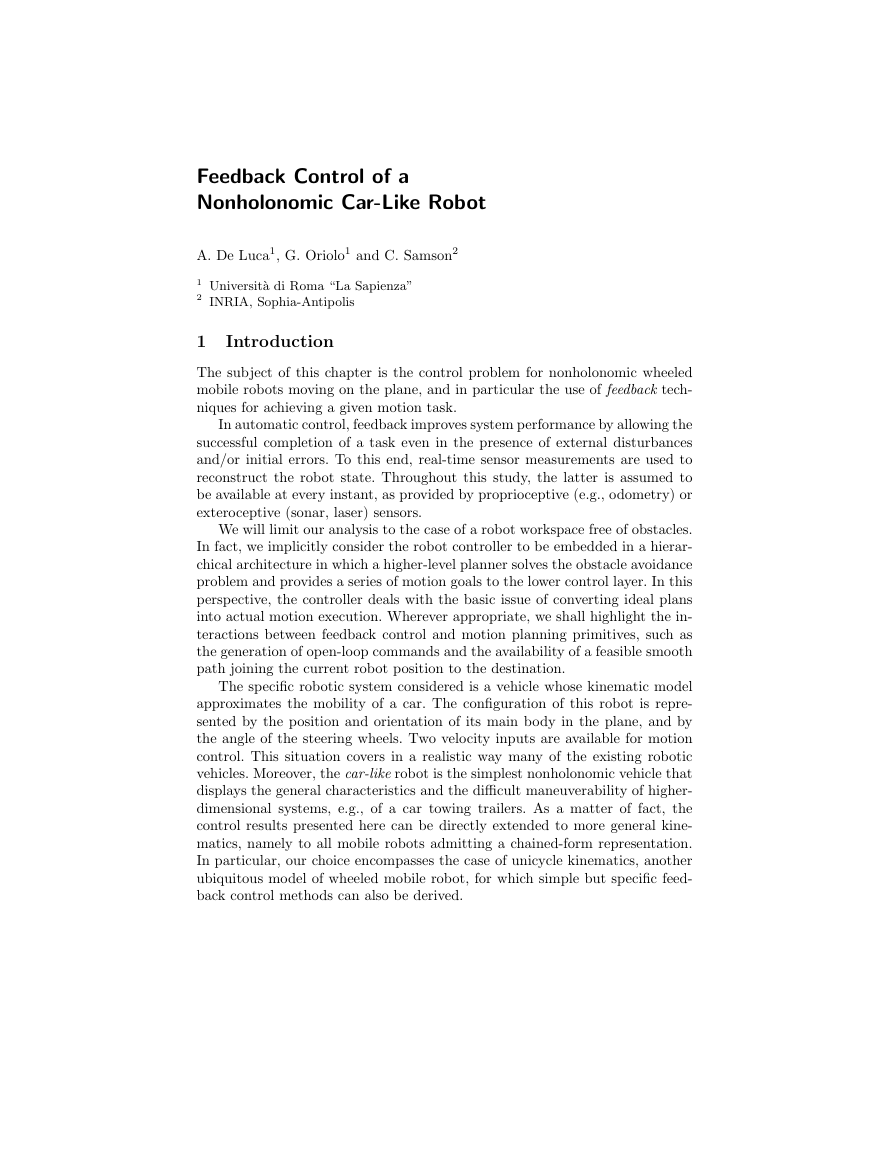
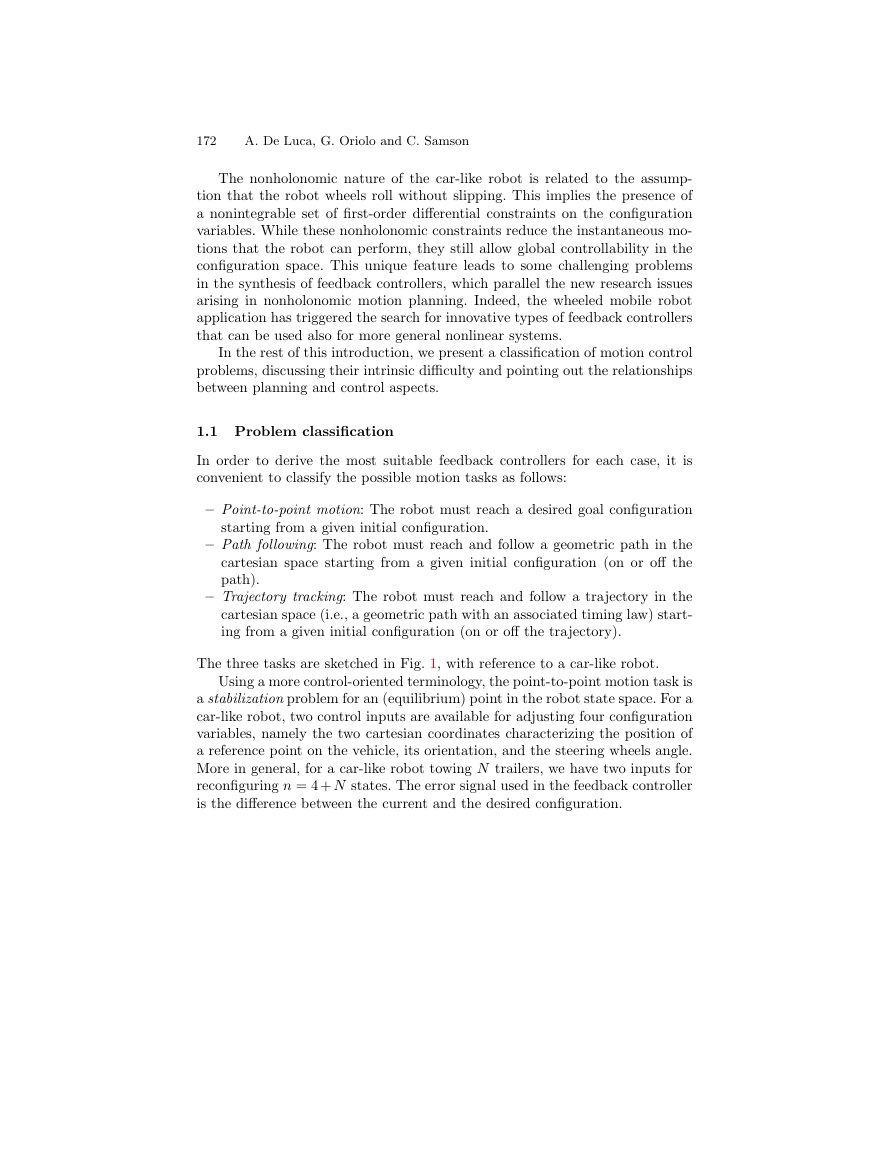

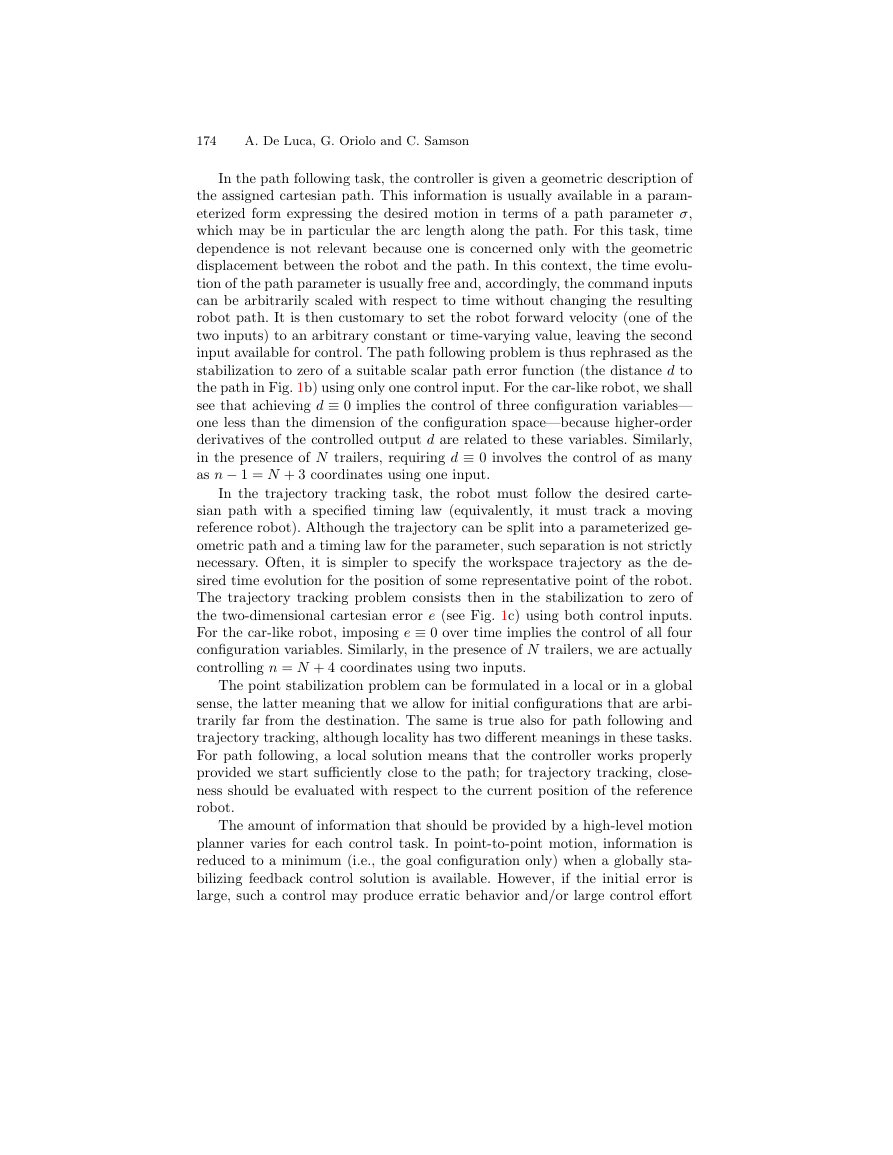
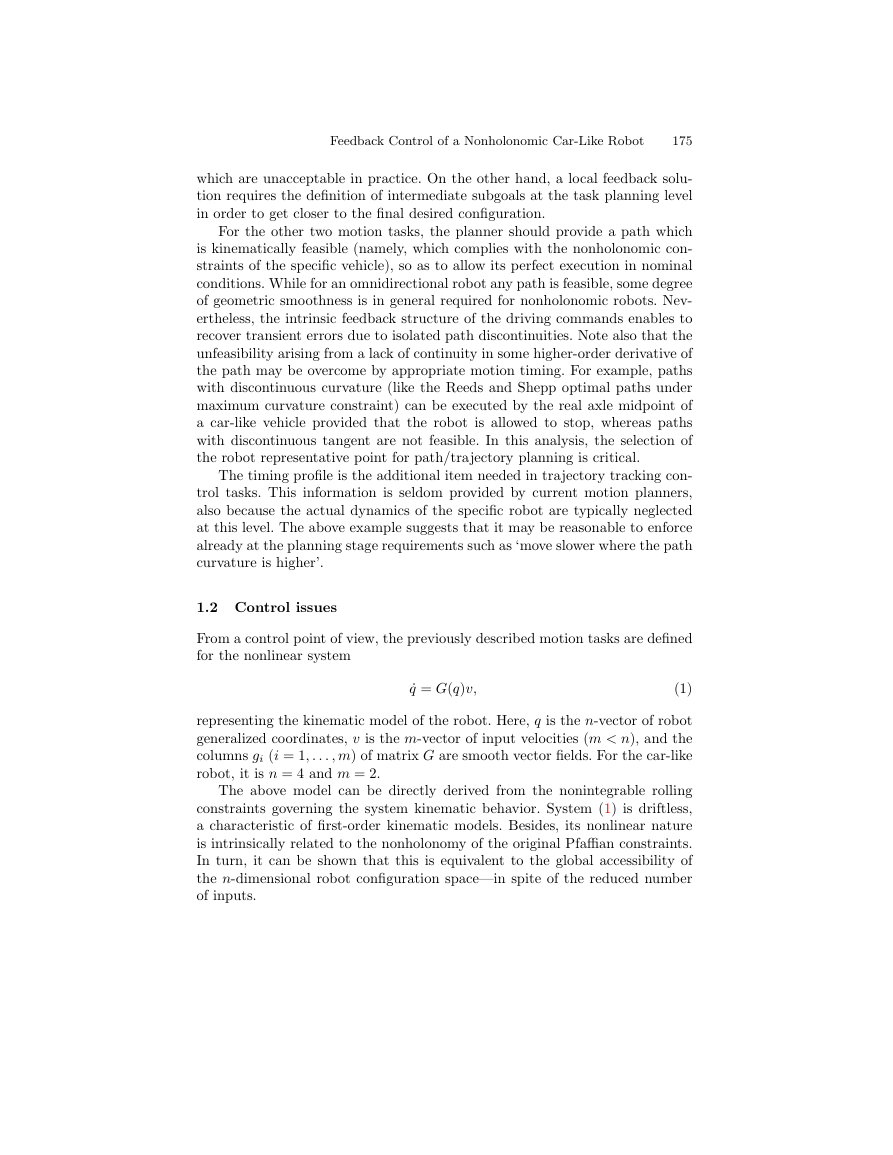
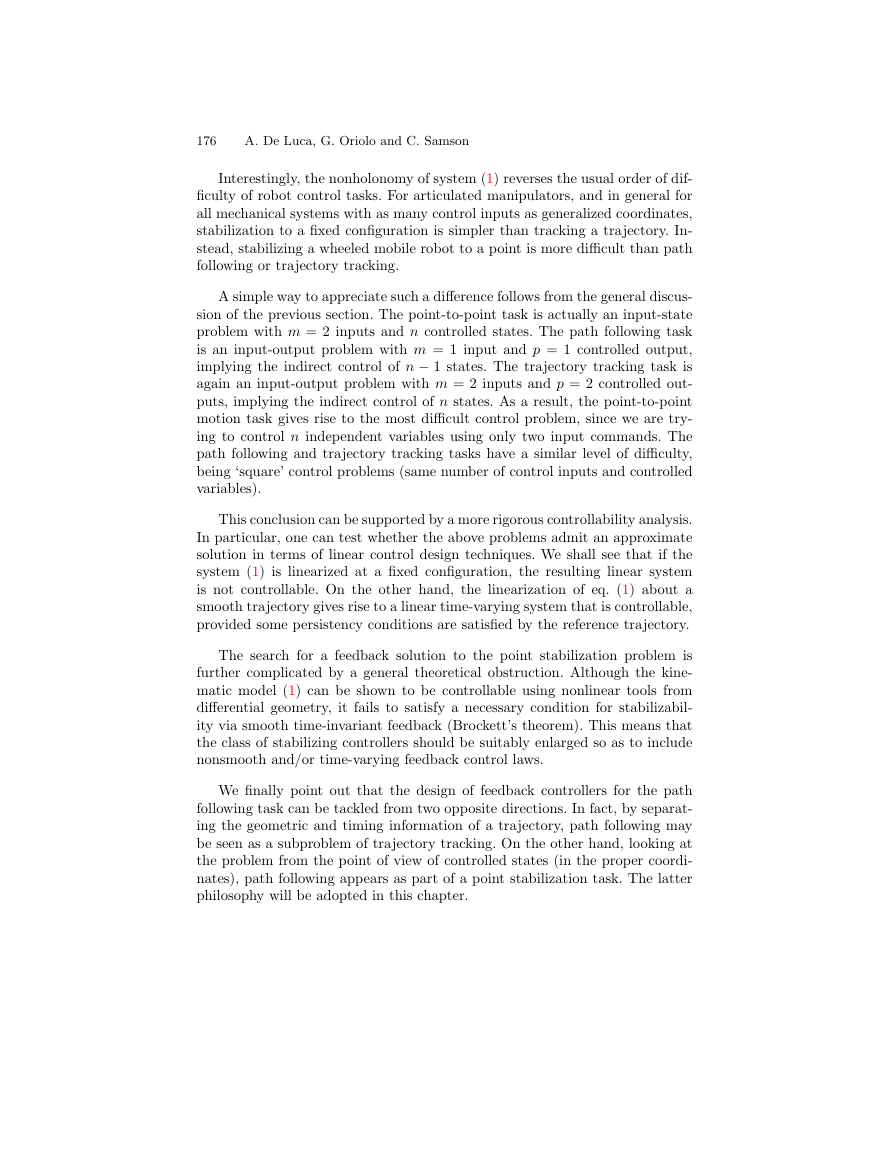
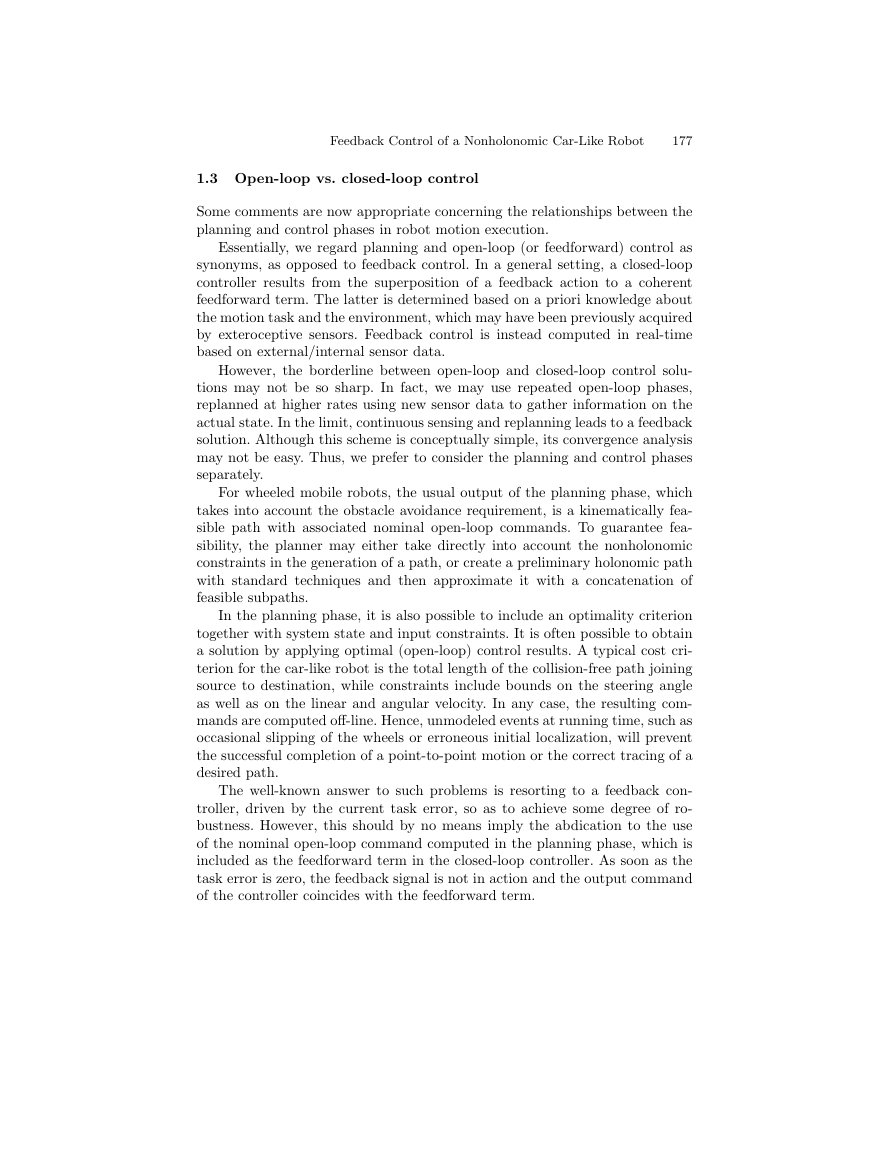








 2023年江西萍乡中考道德与法治真题及答案.doc
2023年江西萍乡中考道德与法治真题及答案.doc 2012年重庆南川中考生物真题及答案.doc
2012年重庆南川中考生物真题及答案.doc 2013年江西师范大学地理学综合及文艺理论基础考研真题.doc
2013年江西师范大学地理学综合及文艺理论基础考研真题.doc 2020年四川甘孜小升初语文真题及答案I卷.doc
2020年四川甘孜小升初语文真题及答案I卷.doc 2020年注册岩土工程师专业基础考试真题及答案.doc
2020年注册岩土工程师专业基础考试真题及答案.doc 2023-2024学年福建省厦门市九年级上学期数学月考试题及答案.doc
2023-2024学年福建省厦门市九年级上学期数学月考试题及答案.doc 2021-2022学年辽宁省沈阳市大东区九年级上学期语文期末试题及答案.doc
2021-2022学年辽宁省沈阳市大东区九年级上学期语文期末试题及答案.doc 2022-2023学年北京东城区初三第一学期物理期末试卷及答案.doc
2022-2023学年北京东城区初三第一学期物理期末试卷及答案.doc 2018上半年江西教师资格初中地理学科知识与教学能力真题及答案.doc
2018上半年江西教师资格初中地理学科知识与教学能力真题及答案.doc 2012年河北国家公务员申论考试真题及答案-省级.doc
2012年河北国家公务员申论考试真题及答案-省级.doc 2020-2021学年江苏省扬州市江都区邵樊片九年级上学期数学第一次质量检测试题及答案.doc
2020-2021学年江苏省扬州市江都区邵樊片九年级上学期数学第一次质量检测试题及答案.doc 2022下半年黑龙江教师资格证中学综合素质真题及答案.doc
2022下半年黑龙江教师资格证中学综合素质真题及答案.doc